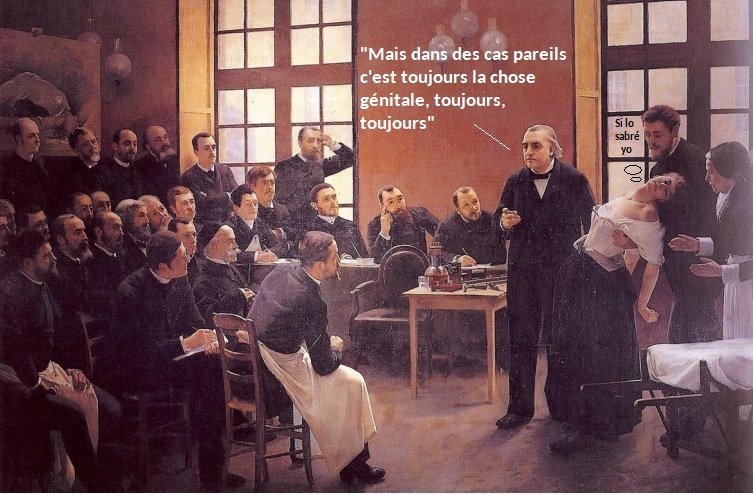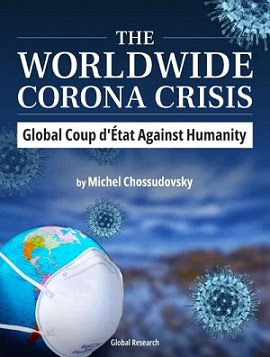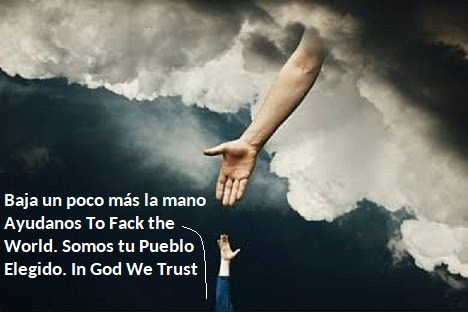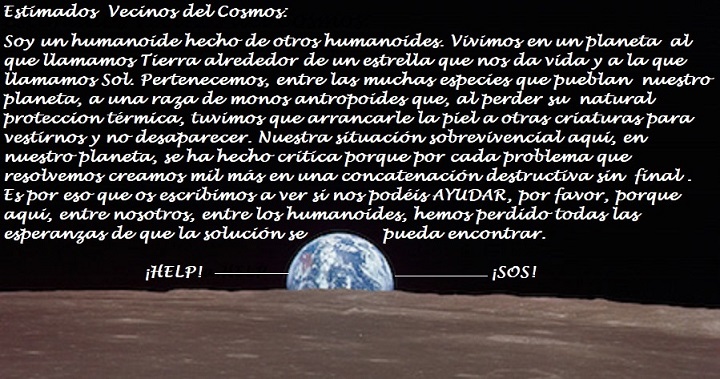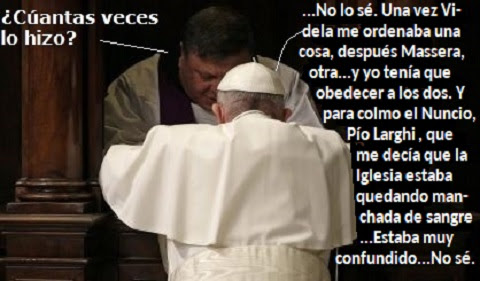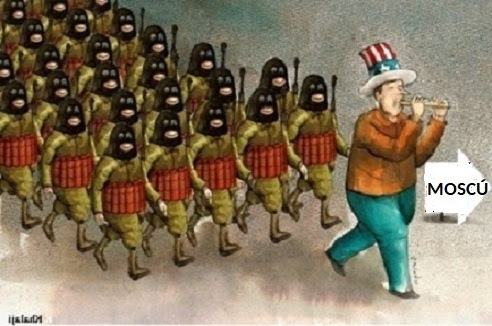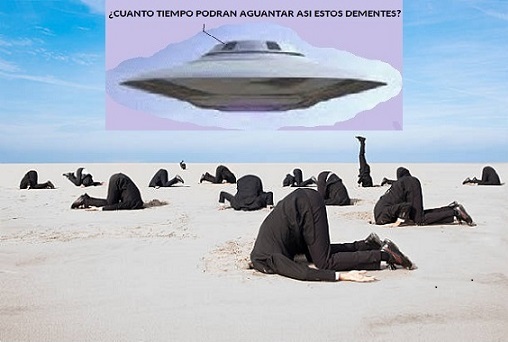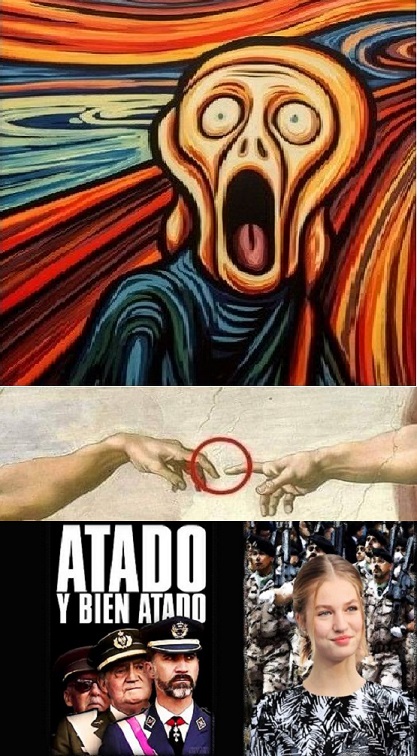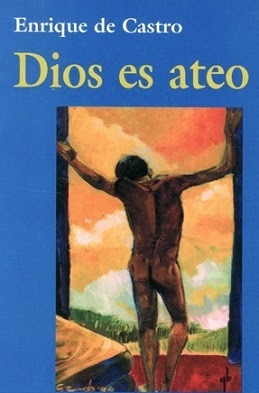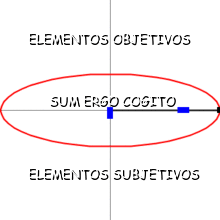Saturday, October 12, 2024
BUDDHISM and PSYCHEDELICS--POST DATA. POST DATA: TRATANDO DE ESCLARECER EL ASUNTO
Foto sacada en los campos de Villalba del Alcor,
Huelva, España. Visitando a mi hermana,
ya en la otra orilla de la Nada,
cuándo el Budismo y lo Psicodélico
se hacen solo espejismos del viento que pasa...
bajo una realidad aplastante que dicta
sus normas y sus recapitulaciones a ultranza.
(Hemos agrandado la foto. Hemos agrandado el pasado,
que, ya lejano, de puretas encorvados y car-comidos anci-anos,
ya no entra ni cabe el narciso centripetismo del culto al yo-yo
de lo-bien-que-salgo. Hemos agrandado el pasado
para verlo mejor -y mas claro- con este sutil periscopio
que desde nuestro submarino llevamos colgado
soportando las cargas de profundidad que el Tiempo
nos tira desde todos los lados...Que el pasado,
en la medida que de nuevo nos acercamos a él
para salir de este campo de concentración que habitamos,
más importancia cobran los temps retrouvé proustianos.
A grosso modo, más o menos, hermanos...
--Por cierto, a la izquierda de la foto, mi cuñao,
ya también en la orilla de la Nada dónde, con su mujer
-mi hermana- los dos estaran flotando, lejos, por suerte,
de este rollo del Zig Zag Zen, ZZZ...onomatopeya del sueño de lo soñado.
(Originalmente publicado
en Agosto, 2009, San Diego, CA.)
ROGER WALSH
ZIG ZAG ZEN
Buddhism and Psychedelics
MYSTICISM; CONTEMPLATIVE AND CHEMICAL
Buddhism and Psychedelics
MYSTICISM; CONTEMPLATIVE AND CHEMICAL
ROGER WALSH
Mystical experiences are usually conceived of as coinciding with altered states of consciousness. As a result, a consideration of mystical states should begin with a discussion of consciousness itself. Yet the nature of consciousness is one of the most fundamental and difficult of all philosophical questions.
The answers to this question have ranged across an enormous spectrum throughout cultures and eras. At one extreme, they include the idea that consciousness is a mere by-product of matter; this is the philosophy of materialism. At the other extreme is the idea that consciousness is the fundamental substrate of reality; this is the philosophy of absolute idealism as proposed, for example, by Yogachara Buddhism.
(¿Como puede ser posible cuando la existencia antecede a la esencia, es decir, cuando primero se vive y despues de piensa? --La vida hace a la conciencia -como dice Marx-, no al contrario--; entónces esto último es una consecuencia de lo primero y no al revés (aúnque haya una interrelación dialéctica entre ambas) como propone el budismo; lo que este propone es que "dios" --la conciencia crea al mundo y no el mundo a "dios"; absurdo--)
For Nietzsche, consciousness was a suffering-producing disease of life, while for the Vedanfic religion of India, it is being and bliss. Small wonder, then, that two contemporary researchers, Douglas R. Hofstadter and Daniel Dennett, claim "So far there is no good theory of consciousness. There is not even agreement about what a theory of consciousness would be like. Some have gone so far as to deny that there is any real thing for the term 'consciousness' to name" (Hofstadter and Dennett, 1982).
Yet whatever consciousness is, the desire to alter it is clearly common and widespread. In a cross-cultural survey, anthropologist Erika Bourguignon found that 90 percent of the several hundred societies she surveyed possessed institutionalized means to alter states of consciousness.
(--Antes que nada hay que asentar y dejar claro que si, que el deseo de alterar la conciencia es claramente común y extendido, pero esta alteración, más que nada --más que con propósitos metafísicos ontológicos psicodélicos, pertenece al deseo consciente de no seguir interpetando al mundo, sino de cambiarlo--. Lo contrario es una manera subrepticia --prestidigitacional-- de querer aceptar lo que con nuestra conciencia racional no podemos alcanzar, y es por lo que, entónces, recurrimos al truco, a la artimaña, a lo marsupial, ese vientre, esa bolsa extra dónde ocultamos --a la vista de todos-- esa criatura que es negada por el mundo alienante donde vivimos y que tratamos de sublimar en el plano pseudoespiritual)
She concluded that "this represents a striking finding and suggests that we are, indeed, dealing with a matter of major importance, not merely a list of anthropological esoterica" (Bourguignon, 1973). Moreover, she found that in traditional societies, these altered states were viewed as sacred, almost without exception. In his book The Natural Mind, Andrew Weil, a leading researcher on psychoactive substances, concluded that "the desire to alter consciousness periodically is an innate normal drive analogous to hunger or sexual desire" (Weil, 1972).
If this is so, it raises the obvious question of the nature of an "optimal" state of consciousness. This is the question I would like to discuss here, along with a related issue of whether psychedelics can ever induce these optimal states.
'A HIGH HISTORY OF BUDDHISM IN AMERICA'
Rick Fields
Rick Fields
....Now, in the new century, we may be seeing a generation who have steeped themselves in practice become inspired to take another, more mature—and more penetrating—look at psychedelics.
During the soporific fifties, access to both psychedelics and Buddhism was limited to a small but influential elite. A British psychiatrist working in Canada, Dr. Humphry Osmond, enlisted Aldous Huxley as a subject for his experiments with mescaline in Los Angeles one afternoon in the middle of May 1953.
Huxley was well prepared. He and his fellow expatriate, the writer Gerald Heard, had studied Vedanta and practiced disciplined meditation for some years, and Huxley had ransacked the world's mystical writings for his anthology The Perennial Philosophy.
Sitting in his garden with Dr. Osmond, he experienced the grace and transfiguration he had read about. Remembering a koan from one of D.T. Suzuki's essays, "What is the Dharma-Body of the Buddha?" he found the answer: "The hedge at the bottom of the garden." What had previously seemed "only a vaguely pregnant piece of nonsense" was now as clear as day. "Of course, the Dharma-Body of the Buddha was the hedge at the bottom of the garden," he reported in The Doors of Perception. "
At the same time, and no less obviously, it was these flowers, it was anything that I—or rather the blessed not-I, released for a moment from my throttling embrace—cared to look at."
Of course Huxley still had his famous wits about him. "I am not so foolish as to equate what happens under the influence of mescaline . . . with the realization of the end and ultimate purpose of human life: Enlightenment," he reassured his reader. "All I am suggesting is that the mescaline experience is what Catholic theologians call 'a gratuitous grace,' not necessary to salvation but potentially helpful and to be accepted thankfully, if made available."
When Maria, Huxley's wife of more than thirty years, lay dying of cancer, he read to her the reminders from the Tibetan Book of the Dead, reducing them to their simplest form and repeating them close to her ear: "Let go, let go. Go forward into the light. Let yourself be carried into the light." He continued after she had stopped breathing, "tears streaming down his face, with his quiet voice not breaking," his son Matthew remembered.
("Ir hacia la luz" al morir; no parece absudo. Vamos hacia la "luz"; hacia que luz?; hacia la luz de las sombras y las descomposicion de cuerpo y mente? A veces caemos en la trampa e las palabras...hasta en la hora de la mierte)
A few years earlier, in July 1953, the ex-banker ethnomycologist Gordon Wasson and his wife, Valentina, had reached the Mazatec village of Huautla de Jimenez, where they discovered the magic psilocybin mushrooms (teonanacatl, the "flesh of the gods") and managed to take part in an all-night velada. Wasson's evenhanded and respectful article on his adventures was published by Life in 195 7. The article was read by a Berkeley psychologist, Frank Barron, who had tried some of the mushrooms, and passed on his enthusiasm to another academic psychologist and old friend, Timothy Leary. Before taking up his new job at Harvard's Center for the Study of Personality, Leary spent the summer in Cuernavaca, Mexico. Naturally, he tried the mushrooms. "The journey lasted a little over four hours," he wrote. "Like almost everyone who had the veil drawn, I came back a changed man" (Leary, f 983).
Leary was now more interested in transcendence then personality assessment. As head of the Harvard Psychedelic Drug Research Project, he ran a session for MIT professor Huston Smith, who made the experience available as a laboratory experiment for his seminars in mysticism. Next, in a now-famous double-blind experiment performed in 1962 on Good Friday in a chapel of the Boston University Cathedral, divinity students were given either psilocybin or a placebo. To no one's surprise, only those who had taken the psychedelic sacrament reported what appeared to be bona fide mystical experiences.
Time published a favorable report, with reassuring quotes from Professor Walter Clark of Andover-Smith and other leading theologians. "We expected that every priest, minister, rabbi, theologian, philosopher, scholar, and just plain God-seeking man, woman, and child in the country would follow up the implications of the study," wrote Leary. Instead, "a tide of disapproval greeted the good news." What followed was much worse. As use spread and the less expensive and much more powerful LSD became the drug of choice, all heaven and hell broke loose. Huxley, while guest lecturing at MIT in the sixties, advised discretion, keeping the drugs inside a small, charmed circle—a kind of aristocratic mystery school. Leary put forth a plan for training and certifying guides. But it was all too much, too fast, and too late. A generation gap had been blown open. The old were appalled, the young enthralled
Leary and Alpert left Harvard in 1963.
Leary and Alpert left Harvard in 1963.
Now they were but one wave, albeit a very visible and noisy one, in a counterculture transformation that was sweeping across America and about to crest in San Francisco. The center of activity was of course the Haight-Ashbury district, which was just a short stroll from a Soto Zen mission, Sokoji, and its American offshoot the San Francisco Zen Center. But the spiritual atmosphere was more than Zen—it was eclectic, visionary, polytheistic, ecstatic, and defiantly devotional. The newspaper of the new vision, the San Francisco Oracle, exploded in a vast rainbow that encompassed everything in one great Whitmanesque blaze of light and camaraderie. North American Indians, Shiva, Kali, Buddha, tarot, astrology, Saint Francis, Zen, and tantra all combined to sell fifty thousand copies on streets that were suddenly teeming with people.
When the Oracle printed the Heart Sutra, it presented a double spread of the Zen Center version complete with Chinese characters, but also with a naked goddess, drawn in the best Avalon ballroom psychedelic. While the Beats had dressed in existential black and blue, this new generation wore plumage—beads and feathers worthy of the most flaming tropical birds. If the previous generation had been gloomy atheists attracted to Zen by iconoclastic directives—If "you meet the Buddha, kill him!"—these new kids were, as Gary Snyder told Dom Aelred Graham in a 1967 interview in Kyoto, "unabashedly religious. They love to talk about God or Christ or Vishnu or Shiva."
Snyder himself had gotten a firsthand look at the counterculture when he returned from Japan for a short visit in 1966. He was just in time for the first Be-in at Golden Gate Park, where he was joined by a number of friends from the early Beat days. Allen Ginsberg was there, as were Lawrence Ferlinghetti and Michael McClure. Kerouac was conspicuous by his brooding absence. He wanted nothing to do with it all. (When Leary had offered him LSD back in Ginsberg's apartment in New York he had objected: "Walking on water wasn't built in a day") These new hippies horrified him. When a bunch of kids showed up at his mother's house in Northampton, Long Island, with jackets that said "Dharma Bums" across the back, he slammed the door in their faces.
But now, at the Be-in, with the sun shining through a deep blue sky and thousands of people at ease in all their finery on the meadow, Snyder read his poems and Ginsberg chanted the Heart Sutra to clear the meadows of lurking demons.
Also present on the stage that afternoon were Timothy Leary and Richard Alpert, the two ex-Harvard psychology professors, who in three short years had become prophetic psychedelic pied pipers. Whatever else LSD became in time, at that moment it was the messenger that led a fair number of people into the dazzling land of their own. mind. What had begun, as the private discovery of a few intellectuals and experimenters had spread in a flash, and for a split second of history it was as if everyone's veil had been rent and all the archetypes of the unconscious now sprang forth.
There were those who claimed that psychedelics had changed the rules of the game, and that the mystic visions once enjoyed only by saints could now be had by anyone. In any case, it was obvious to the university researchers at Harvard, who had searched the scientific literature in vain, that the scriptures of Buddhism (and Hinduism) contained descriptions that matched what they had seen and felt. So Timothy Leary recast the verses of theTaoTe Ching in a book called Psychedelic Prayers, and in 1962 Timothy Leary, Ralph Metzner, and Richard Alpert adapted the Bardo Thodol, the Tibetan Book of the Dead, retranslated from Evans-Wentz's "Anglo-Buddhist to American Psychedelic" in The Psychedelic Experience: A Manual Based on the Tibetan Book of the Dead. Because the book was apparently meant to acquaint a dying person with the liberation of the Clear Light of Reality and then guide him or her through the peaceful and wrathful deities of the bardo it was fairly easy to recast it as a guide in which physical death was reconfigured as the death of the ego during a psychedelic trip.
The Psychedelic Experience, published in 1964, went through sixteen editions and was translated into seven languages.
One of the manuscript's most interested readers was Aldous Huxley, who called Leary from Los Angeles, where Huxley was dying of cancer. When Leary flew out to see him, Huxley asked him to guide him through the bar-dos. Leary suggested that it would be better if Huxley's second wife, Laura, guided the sessions. "No, I don't want to put any more emotional pressure on her," Huxley replied. "I plan to die during that trip, after all." In the end, Laura did give him the sacrament (LSD) and read him the instructions from the Tibetan Book of the Dead. And so, in I 963, Aldous Huxley passed peacefully into the Clear Light of Reality.
It was impossible for any roshi to ignore the question of LSD and its relationship to Buddhism. KounYamada Roshi, Yatsutani Roshi's chief disciple in Japan, was said to have tried it only to report, "This isn't form is the same as emptiness; this is emptiness is the same as form." If Suzuki Roshi said (as Gary Snyder told Dom Aelred Graham) that "people who have started to come to the zendo from LSD experiences have shown an ability to get into good zazen very rapidly," he also said in New York (as Harold Talbott, Graham's secretary, told Snyder) "that the LSD experience was entirely distinct from Zen." In any case, it seemed that in practice, Suzuki Roshi mostly ignored it. When Mary Farkas of the First Zen Institute asked him what he thought of the "Zen-drug tie-up we kept hearing so much of," she gathered from his reply "that students who had been on drugs gradually gave them up and that highly structured and supervised activities left little opportunity and lessened inclination."
Others in the Zen world were equally concerned. In Japan, D.T. Suzuki wrote an essay as part of a symposium on "Buddhism and Drugs" for The Eastern Buddhist, in which he warned that the popularity of LSD "has reached a point where university professors organize groups of mystical drug takers with the intention of forming an intentional society of those who seek 'internal freedom.' . . . All this sounds dreamy indeed," he wrote, "yet they are so serious in their intention, that Zen people cannot simply ignore their movements."
If Dr. Suzuki sounded the alarm, the Americans were more moderate in their reactions. Ray Jordan, a former student of Nyogen Senzaki's and then an assistant professor of psychology, had written in Psychologic that "LSD might be a useful aid both to the realization of prajrm [wisdom], and to the development of meditational practice," but a sesshin with Yasutani-roshi had since convinced him that he had been mistaken. The sesshin had "included a moment which the roshi identified as kensho," and Jordan was now able to testify that "even the deepest and most powerful realizations associated with LSD were weak and dim compared to the reality and clarity of sesshin events."
Jordan admitted that "in a small number of cases psychedelic experiences may have revealed to persons the everyday pre-sentness of the Pure Buddha Land [but] from that point on the psychedelics are of no value whatsoever in so far as the Way is concerned. Without relying on anything one must walk step by step, moment by moment in the daily reality of the Pure Land."
Alan Watts was more sympathetic. He pointed out, to begin with, that everyone must speak for himself since so much depended on the "mental state of the person taking the chemical and circumstances under which the experiment is conducted." In Watts's case, these had been benign, and LSD had
THE WORLDS WISDOM
Philip Novak
THE WORLDS WISDOM
Philip Novak
3. We Have Drunk Soma and Become Immortal
All one hundred and fourteen hymns of the ninth book of the Rig-Veda are addressed to Soma, the god who inhabits a mysterious psychotropic beverage, said in the Vedas to be the food of the gods. Soma probably ranks behind only Indra and Agni in Vedic popularity.
All one hundred and fourteen hymns of the ninth book of the Rig-Veda are addressed to Soma, the god who inhabits a mysterious psychotropic beverage, said in the Vedas to be the food of the gods. Soma probably ranks behind only Indra and Agni in Vedic popularity.
Of the sweet food I have partaken wisely, That stirs the good thoughts, best banisher of trouble, On which to feast, all gods as well as mortals, Naming the sweet food "honey," come together. . . .
We have drunk Soma, have become immortal, Gone to the light have we, the gods discovered. What can hostility do against us? What, O Immortal, mortal man's fell purpose?
We have drunk Soma, have become immortal, Gone to the light have we, the gods discovered. What can hostility do against us? What, O Immortal, mortal man's fell purpose?
Joy to our heart be thou, when drunk, O Indu, Like father to a son, most kind, O Soma; Thoughtful like friend to friend, O thou of wide fame, Prolong our years that we may live, O Soma.
These glorious freedom-giving drops by me imbibed Have knit my joints together as straps a chariot; From broken legs may Soma drops protect me, May they from every illness keep me far removed... .
Be gracious unto us for good, King Soma;
We are thy devotees; of that be certain.
When might and wrath display themselves, O Indu,
Do not abandon us, as wished by foemen.
Protector of our body art thou, Soma,
In every limb hast settled man-beholding:
If we infringe thine ordinances be gracious
As our good friend, O god, for higher welfare.. . .
Be gracious unto us for good, King Soma;
We are thy devotees; of that be certain.
When might and wrath display themselves, O Indu,
Do not abandon us, as wished by foemen.
Protector of our body art thou, Soma,
In every limb hast settled man-beholding:
If we infringe thine ordinances be gracious
As our good friend, O god, for higher welfare.. . .
................................................................
"MEDITATION" AND "IRRITATION"
Is not by "meditation" (the 'yoga-yogi-status'), but by "irritation" (by being alive in Heidegger's 'Dasein') that we are going to answer epistemologically this twisted world and try to improve it in the same sense that Marx said that "all what philosophy had done was interpret, 'meditate' on the world, instead of changing it."
Now, we can see, clearly, why the apolegetics of this Orwellian and oppressive system stimulate much more the former than the latests. Because this stimulated response of immobilization combine the two essential premises of the regime:
Money and Ideological Class Tool of Control.
The former represents a thriving industry of hundreds of millions of dolars in net profit.
The second because neutralize, and divert energies (endogenous aggression, libidinal sofocation and political frustation) towards the sublimation process that Marcuse, in "Eros and Civilization", brilliantly describes.
This is why Wilhelm Reich had this in his mind:
("The Function of the Orgasm",
Wilhelm Reich
ZIG ZAG ZEN
Budismo y Psicodélicos
MISTICISMO; CONTEMPLATIVO Y QUÍMICO
ROGER WALSH
Budismo y Psicodélicos
MISTICISMO; CONTEMPLATIVO Y QUÍMICO
ROGER WALSH
Las experiencias místicas suelen concebirse como coincidentes con estados alterados de conciencia. Por ello, el estudio de los estados místicos debería comenzar con un análisis de la conciencia misma. Sin embargo, la naturaleza de la conciencia es una de las cuestiones filosóficas más fundamentales y difíciles.
Las respuestas a esta pregunta han abarcado un espectro enorme a lo largo de las culturas y las épocas. En un extremo, se encuentra la idea de que la conciencia es un mero subproducto de la materia; ésta es la filosofía del materialismo. En el otro extremo está la idea de que la conciencia es el sustrato fundamental de la realidad; ésta es la filosofía del idealismo absoluto, tal como la propone, por ejemplo, el budismo yogachara.
(Como puede ser posible cuando la existencia antecede a la esencia, es decir, cuando primero se vive y despues de piensa? --La vida hace a la conciencia -como dice Marx-, no al contrario--; entonces esto ultimo es una consecuencia de lo primero y no al reves como propone el budismo; lo que este propone es que "dios" --la conciencia crea al mundo y no el mundo a "dios"--)
Para Nietzsche, la conciencia era una enfermedad de la vida que producía sufrimiento, mientras que para la religión védica de la India, es ser y felicidad. No es de extrañar, entonces, que dos investigadores contemporáneos, Douglas R. Hofstadter y Daniel Dennett, afirmen que "hasta ahora no existe una buena teoría de la conciencia. Ni siquiera hay acuerdo sobre cómo sería una teoría de la conciencia. Algunos han llegado al extremo de negar que exista algo real que el término 'conciencia' pueda nombrar" (Hofstadter y Dennett, 1982).
Sea cual fuere el concepto de conciencia, el deseo de alterarla es claramente común y generalizado. En un estudio transcultural, la antropóloga Erika Bourguignon descubrió que el 90 por ciento de los cientos de sociedades que estudió poseían medios institucionalizados para alterar los estados de conciencia.
Concluyó que "se trata de un hallazgo sorprendente y sugiere que, en efecto, nos encontramos ante un asunto de gran importancia, no simplemente una lista de esoterismo antropológico" (Bourguignon, 1973). Además, descubrió que en las sociedades tradicionales, estos estados alterados se consideraban sagrados, casi sin excepción. En su libro The Natural Mind, Andrew Weil, un destacado investigador sobre sustancias psicoactivas, concluyó que "el deseo de alterar la conciencia periódicamente es un impulso normal innato análogo al hambre o al deseo sexual" (Weil, 1972).
Si esto es así, se plantea la cuestión obvia de la naturaleza de un estado de conciencia "óptimo". Ésta es la cuestión que me gustaría tratar aquí, junto con una cuestión relacionada: si los psicodélicos pueden inducir estos estados óptimos.
'UNA HISTORIA DE ALTA CALIDAD DEL BUDISMO EN ESTADOS UNIDOS'
Rick Fields
Rick Fields
...Ahora, en el nuevo siglo, podemos estar viendo una generación que se ha sumergido en la práctica y se siente inspirada a adoptar otra perspectiva, más madura y más penetrante, sobre los psicodélicos.
Durante los soporíferos años cincuenta, el acceso tanto a los psicodélicos como al budismo estaba limitado a una pequeña pero influyente élite. Un psiquiatra británico que trabajaba en Canadá, el doctor Humphry Osmond, reclutó a Aldous Huxley como sujeto de sus experimentos con mescalina en Los Ángeles una tarde de mediados de mayo de 1953.
Huxley estaba bien preparado. Él y su compañero expatriado, el escritor Gerald Heard, habían estudiado el Vedanta y practicado la meditación disciplinada durante algunos años, y Huxley había escudriñado los escritos místicos del mundo para su antología The Perennial Philosophy.
Sentado en su jardín con el Dr. Osmond, experimentó la gracia y la transfiguración sobre las que había leído. Recordando un koan de uno de los ensayos de DT Suzuki, "¿Qué es el Cuerpo del Dharma del Buda?", encontró la respuesta: "El seto al fondo del jardín". Lo que antes le había parecido "sólo una tontería vagamente preñada" ahora estaba tan claro como el día. "Por supuesto, el Cuerpo del Dharma del Buda era el seto al fondo del jardín", informó en Las puertas de la percepción. "
Al mismo tiempo, y no menos obviamente, eran estas flores, era cualquier cosa que yo —o más bien, el bendito no-yo, liberado por un momento de mi abrazo estrangulador— quisiera mirar.
Por supuesto, Huxley todavía conservaba su famosa cordura. "No soy tan tonto como para equiparar lo que ocurre bajo la influencia de la mescalina... con la realización del fin y el propósito último de la vida humana: la Ilustración", aseguró a su lector. "Lo único que estoy sugiriendo es que la experiencia con la mescalina es lo que los teólogos católicos llaman 'una gracia gratuita', no necesaria para la salvación, pero potencialmente útil y que debe aceptarse con gratitud, si se pone a disposición".
Cuando María, la esposa de Huxley durante más de treinta años, se estaba muriendo de cáncer, él le leyó los recordatorios del Libro tibetano de los muertos, reduciéndolos a su forma más simple y repitiéndolos cerca de su oído: "Déjate ir, déjate ir. Avanza hacia la luz. Déjate llevar hacia la luz". Continuó después de que ella dejó de respirar, "las lágrimas corrían por su rostro, pero su voz tranquila no se quebró", recordó su hijo Matthew.
("Ir hacia la luz" al morir; no parece absudo. Vamos hacia la "luz"; ¿hacia que luz?; ¿hacia la luz de las sombras y las descomposicion de cuerpo y mente? A veces caemos en la trampa e las palabras. ..hasta en la hora de la mierte)
Unos años antes, en julio de 1953, el exbanquero etnomicólogo Gordon Wasson y su esposa, Valentina, habían llegado al pueblo mazateco de Huautla de Jiménez, donde descubrieron los hongos mágicos de psilocibina (teonanacatl, la "carne de los dioses") y lograron participar en una velada que duró toda la noche. El artículo imparcial y respetuoso de Wasson sobre sus aventuras fue publicado por Life en 1957. El artículo fue leído por un psicólogo de Berkeley, Frank Barron, que había probado algunos de los hongos, y transmitió su entusiasmo a otro psicólogo académico y viejo amigo, Timothy Leary. Antes de aceptar su nuevo trabajo en el Centro para el Estudio de la Personalidad de Harvard, Leary pasó el verano en Cuernavaca, México. Naturalmente, probó los hongos. "El viaje duró un poco más de cuatro horas", escribió. "Como casi todos los que tenían el velo corrido, regresé como un hombre cambiado" (Leary, f 983).
Leary estaba ahora más interesado en la trascendencia que en la evaluación de la personalidad. Como director del Proyecto de Investigación de Drogas Psicodélicas de Harvard, dirigió una sesión para el profesor del MIT Huston Smith, quien puso la experiencia a disposición como experimento de laboratorio para sus seminarios sobre misticismo. A continuación, en un experimento doble ciego ahora famoso realizado en 1962 el Viernes Santo en una capilla de la Catedral de la Universidad de Boston, a los estudiantes de teología se les administró psilocibina o un placebo. Para sorpresa de nadie, solo aquellos que habían tomado el sacramento psicodélico informaron de lo que parecían ser experiencias místicas genuinas.
La revista Time publicó un informe favorable, con citas tranquilizadoras del profesor Walter Clark de Andover-Smith y otros teólogos destacados. "Esperábamos que todos los sacerdotes, ministros, rabinos, teólogos, filósofos, eruditos y, sencillamente, hombres, mujeres y niños que buscaban a Dios en el país siguieran las implicaciones del estudio", escribió Leary. En cambio, "una ola de desaprobación recibió las buenas noticias". Lo que siguió fue mucho peor. A medida que se extendió el uso y el LSD, menos costoso y mucho más potente, se convirtió en la droga de elección, se desató el cielo y el infierno. Huxley, mientras daba conferencias en el MIT en los años sesenta, recomendaba discreción, manteniendo las drogas dentro de un círculo pequeño y encantador, una especie de escuela de misterios aristocrática. Leary presentó un plan para capacitar y certificar a los guías. Pero todo fue demasiado, demasiado rápido y demasiado tarde. Se había abierto una brecha generacional. Los viejos estaban horrorizados, los jóvenes fascinados.
Leary y Alpert dejaron Harvard en 1963.
Leary y Alpert dejaron Harvard en 1963.
Ahora no eran más que una ola, aunque muy visible y ruidosa, de una transformación contracultural que se extendía por todo Estados Unidos y que estaba a punto de alcanzar su punto máximo en San Francisco. El centro de actividad era, por supuesto, el distrito de Haight-Ashbury, que se encontraba a un breve paseo de una misión zen soto, Sokoji, y su filial estadounidense, el Centro Zen de San Francisco. Pero la atmósfera espiritual era más que zen: era ecléctica, visionaria, politeísta, extática y desafiantemente devocional. El periódico de la nueva visión, el San Francisco Oracle, explotó en un vasto arco iris que lo abarcaba todo en un gran resplandor de luz y camaradería al estilo Whitman. Los indios norteamericanos, Shiva, Kali, Buda, el tarot, la astrología, San Francisco, el zen y el tantra se combinaron para vender cincuenta mil ejemplares en calles que de repente estaban repletas de gente.
Cuando Oracle publicó el Sutra del Corazón, presentó una doble página de la versión del Centro Zen, completa con caracteres chinos, pero también con una diosa desnuda, dibujada al mejor estilo psicodélico de los salones de baile de Avalon. Mientras que los Beats se habían vestido de negro y azul existencialistas, esta nueva generación lucía plumaje, cuentas y plumas dignas de los pájaros tropicales más flameantes. Si la generación anterior había sido una de ateos sombríos atraídos al Zen por directivas iconoclastas —si "te encuentras con el Buda, mátalo"—, estos nuevos muchachos eran, como Gary Snyder le dijo a Dom Aelred Graham en una entrevista de 1967 en Kioto, "descaradamente religiosos. Les encanta hablar de Dios o Cristo o Vishnu o Shiva".
El propio Snyder había podido observar de primera mano la contracultura cuando regresó de Japón para una breve visita en 1966. Llegó justo a tiempo para el primer Be-in en el Golden Gate Park, donde se le unieron varios amigos de los primeros días de la era beat. Allen Ginsberg estaba allí, al igual que Lawrence Ferlinghetti y Michael McClure. Kerouac brillaba por su ausencia melancólica. No quería tener nada que ver con todo eso. (Cuando Leary le había ofrecido LSD en el apartamento de Ginsberg en Nueva York, él había protestado: "Caminar sobre el agua no se hizo en un día"). Estos nuevos hippies lo horrorizaban. Cuando un grupo de chicos se presentó en la casa de su madre en Northampton, Long Island, con chaquetas que decían "Dharma Bums" en la espalda, les cerró la puerta en las narices.
Pero ahora, en el Be-in, con el sol brillando a través de un cielo azul profundo y miles de personas a gusto con sus mejores galas en el prado, Snyder leía sus poemas y Ginsberg cantaba el Sutra del Corazón para limpiar los prados de demonios acechantes.
También estaban presentes en el escenario esa tarde Timothy Leary y Richard Alpert, los dos ex profesores de psicología de Harvard que en tres cortos años se habían convertido en proféticos flautistas psicodélicos. Cualquiera que fuera la otra cosa en la que se convirtió el LSD con el tiempo, en ese momento fue el mensajero que condujo a un buen número de personas a la deslumbrante tierra de su propia mente. Lo que había comenzado como el descubrimiento privado de unos pocos intelectuales y experimentadores se había difundido en un instante, y durante una fracción de segundo de la historia fue como si el velo de todos se hubiera rasgado y ahora salieran a la luz todos los arquetipos del inconsciente.
Hubo quienes afirmaron que los psicodélicos habían cambiado las reglas del juego y que las visiones místicas que antes sólo disfrutaban los santos ahora podían ser disfrutadas por cualquiera. En cualquier caso, era obvio para los investigadores universitarios de Harvard, que habían buscado en vano en la literatura científica, que las escrituras del budismo (y del hinduismo) contenían descripciones que coincidían con lo que habían visto y sentido. Así que Timothy Leary reformuló los versos del Tao Te Ching en un libro llamado Psychedelic Prayers, y en 1962 Timothy Leary, Ralph Metzner y Richard Alpert adaptaron el Bardo Thodol, el Libro tibetano de los muertos, retraducido de "Anglo-Buddhist to American Psychedelic" de Evans-Wentz en The Psychedelic Experience: A Manual Based on the Tibetan Book of the Dead. Dado que el libro aparentemente tenía como objetivo familiarizar a una persona moribunda con la liberación de la Clara Luz de la Realidad y luego guiarla a través de las deidades pacíficas y coléricas del bardo, fue bastante fácil reformularlo como una guía en la que la muerte física se reconfiguraba como la muerte del ego durante un viaje psicodélico.
La experiencia psicodélica, publicada en 1964, tuvo dieciséis ediciones y fue traducida a siete idiomas.
Uno de los lectores más interesados del manuscrito fue Aldous Huxley, quien llamó a Leary desde Los Ángeles, donde Huxley se estaba muriendo de cáncer. Cuando Leary voló para verlo, Huxley le pidió que lo guiara a través de los bar-dos. Leary sugirió que sería mejor que la segunda esposa de Huxley, Laura, guiara las sesiones. "No, no quiero ponerle más presión emocional", respondió Huxley. "Después de todo, planeo morir durante ese viaje". Al final, Laura le dio el sacramento (LSD) y le leyó las instrucciones del Libro tibetano de los muertos. Y así, en 1963, Aldous Huxley pasó pacíficamente a la Clara Luz de la Realidad.
Era imposible para cualquier roshi ignorar la cuestión del LSD y su relación con el budismo. Se decía que KounYamada Roshi, el principal discípulo de Yatsutani Roshi en Japón, lo había probado sólo para decir: "Esto no es que la forma sea lo mismo que el vacío; esto es que el vacío es lo mismo que la forma". Si Suzuki Roshi dijo (como Gary Snyder le dijo a Dom Aelred Graham) que "las personas que han comenzado a llegar al zendo a partir de experiencias con LSD han demostrado una capacidad para entrar en un buen zazen muy rápidamente", también dijo en Nueva York (como Harold Talbott, el secretario de Graham, le dijo a Snyder) "que la experiencia con LSD era completamente distinta del zen". En cualquier caso, parecía que en la práctica, Suzuki Roshi en su mayoría lo ignoraba. Cuando Mary Farkas, del Primer Instituto Zen, le preguntó qué pensaba de la "relación entre el zen y las drogas de la que tanto oímos hablar", dedujo de su respuesta que "los estudiantes que habían consumido drogas las abandonaban gradualmente y que las actividades altamente estructuradas y supervisadas dejaban pocas oportunidades y reducían la inclinación".
Otros en el mundo zen estaban igualmente preocupados. En Japón, DT Suzuki escribió un ensayo como parte de un simposio sobre "Budismo y drogas" para The Eastern Buddhist, en el que advertía que la popularidad del LSD "ha llegado a un punto en el que los profesores universitarios organizan grupos de consumidores de drogas místicas con la intención de formar una sociedad intencional de aquellos que buscan la 'libertad interna'... Todo esto suena realmente a sueño", escribió, "pero son tan serios en su intención, que la gente zen no puede simplemente ignorar sus movimientos".
Si el Dr. Suzuki dio la voz de alarma, los norteamericanos fueron más moderados en sus reacciones. Ray Jordan, un antiguo alumno de Nyogen Senzaki y entonces profesor adjunto de psicología, había escrito en Psychologic que "el LSD podría ser una ayuda útil tanto para la realización de la prajrm [sabiduría] como para el desarrollo de la práctica meditativa", pero una sesshin con Yasutani-roshi lo había convencido de que se había equivocado. La sesshin había "incluido un momento que el roshi identificó como kensho", y Jordan ahora podía testificar que "incluso las realizaciones más profundas y poderosas asociadas con el LSD eran débiles y tenues en comparación con la realidad y la claridad de los eventos de la sesshin".
Jordan admitió que "en un pequeño número de casos, las experiencias psicodélicas pueden haber revelado a las personas la presencia cotidiana de la Tierra Pura de Buda [pero] a partir de ese momento, los psicodélicos no tienen ningún valor en lo que respecta al Camino. Sin depender de nada, uno debe caminar paso a paso, momento a momento en la realidad cotidiana de la Tierra Pura".
Alan Watts se mostró más comprensivo. Señaló, para empezar, que cada uno debe hablar por sí mismo, ya que mucho depende del "estado mental de la persona que toma la sustancia química y de las circunstancias en las que se lleva a cabo el experimento". En el caso de Watts, estas habían sido benignas, y el LSD había
LA SABIDURÍA DEL MUNDO
Philip Novak
LA SABIDURÍA DEL MUNDO
Philip Novak
3. Hemos bebido soma y nos hemos convertido en inmortales
Los ciento catorce himnos del noveno libro del Rig Veda están dirigidos a Soma, el dios que habita en una misteriosa bebida psicotrópica, que según los Vedas es el alimento de los dioses. Probablemente, Soma ocupa el puesto sólo detrás de Indra y Agni en popularidad védica.
Los ciento catorce himnos del noveno libro del Rig Veda están dirigidos a Soma, el dios que habita en una misteriosa bebida psicotrópica, que según los Vedas es el alimento de los dioses. Probablemente, Soma ocupa el puesto sólo detrás de Indra y Agni en popularidad védica.
He comido sabiamente de la dulce comida, que despierta los buenos pensamientos, la mejor desterradora de problemas, con la que todos los dioses y los mortales, al llamar a la dulce comida "miel", se reúnen...
Hemos bebido soma, nos hemos vuelto inmortales, hemos ido a la luz, hemos descubierto a los dioses. ¿Qué puede hacer la hostilidad contra nosotros? ¿Cuál, oh inmortal, es el malvado propósito del hombre mortal?
Hemos bebido soma, nos hemos vuelto inmortales, hemos ido a la luz, hemos descubierto a los dioses. ¿Qué puede hacer la hostilidad contra nosotros? ¿Cuál, oh inmortal, es el malvado propósito del hombre mortal?
Sé tú alegría para nuestro corazón cuando estés borracho, oh Indu; como un padre a su hijo, el más bondadoso, oh Soma; atento como un amigo a su amigo, oh tú, de amplia fama; prolonga nuestros años para que podamos vivir, oh Soma.
Estas gloriosas gotas liberadoras que he bebido han unido mis articulaciones como las correas de un carro; que las gotas de Soma me protejan de las piernas rotas, que me mantengan alejado de toda enfermedad...
Sé misericordioso con nosotros para bien, Rey Soma;
somos tus devotos; de eso tenlo por seguro.
Cuando el poder y la ira se manifiesten, oh Indu,
no nos abandones, como desean los enemigos.
Protector de nuestro cuerpo eres tú, Soma,
en cada miembro has establecido la contemplación del hombre:
si infringimos tus ordenanzas, sé misericordioso
como nuestro buen amigo, oh dios, para un mayor bienestar...
Sé misericordioso con nosotros para bien, Rey Soma;
somos tus devotos; de eso tenlo por seguro.
Cuando el poder y la ira se manifiesten, oh Indu,
no nos abandones, como desean los enemigos.
Protector de nuestro cuerpo eres tú, Soma,
en cada miembro has establecido la contemplación del hombre:
si infringimos tus ordenanzas, sé misericordioso
como nuestro buen amigo, oh dios, para un mayor bienestar...
.................................................
POST DATA
TRATANDO DE ESCLARECER EL ASUNTO:
---------------------
https://sisifocansado.blogspot.com/2010/06/buda-y-marx.html
---------------------------------
https://sisifocansado.blogspot.com/2011/12/el-principe-y-el-carpintero.html
---------------------------------
https://sisifocansado.blogspot.com/2011/12/segunda-parte-el-principe-y-el.html
---------------------------------
Añadido al tercer link:
Thursday, January 14, 2010
"MEDITATION", "IRRITATION" AND "THE FUNCTION OF THE ORGASM" OF WILHELM REICH
Is not by "meditation" (the 'yoga-yogi-status'), but by "irritation" (by being alive in Heidegger's 'Dasein') that we are going to answer epistemologically this twisted world and try to improve it in the same sense that Marx said that "all what philosophy had done was interpret, 'meditate' on the world, instead of changing it."
Now, we can see, clearly, why the apolegetics of this Orwellian and oppressive system stimulate much more the former than the latests. Because this stimulated response of immobilization combine the two essential premises of the regime:
Money and Ideological Class Tool of Control.
The former represents a thriving industry of hundreds of millions of dolars in net profit.
The second because neutralize, and divert energies (endogenous aggression, libidinal sofocation and political frustation) towards the sublimation process that Marcuse, in "Eros and Civilization", brilliantly describes.
This is why Wilhelm Reich had this in his mind:
"Pleasure and joy of life are inconceivable without struggle, painful experiences and self-confrontations.
Psychic health is characterized,
not by the Nirvana theory
of the yogis and the buddhists,
the hedonism of the epicureans,
the renunciation of monaticism,
(or by the pseudo-attitude of the positive
pragmatism of the alienated individual).
Psychic health is characterized by the alternation
between unpleasurable struggle and happiness,
error and truth, deviation and rectificaion,
rational hate and rational love,
rebelliousness and acceptance,
in short:
by the feeling of being fully alive
in all situation of life"
(Es la total negación del budismo.
Es lo que Reich llama el carácter genital,
lejos, muy lejos de su PLAGA EMOCIONAL)
("The Function of the Orgasm",
Wilhelm Reich
Subscribe to:
Comments (Atom)
Blog Archive
- ► 2010 (272)
- ► 2011 (344)
- ► 2012 (355)
- ► 2013 (352)
- ► 2014 (502)
- ► 2015 (416)
- ► 2016 (336)
- ► 2017 (331)
- ► 2018 (296)
- ► 2019 (298)
- ► 2020 (358)
- ► 2021 (359)
- ► 2022 (406)
- ► 2023 (312)
- ▼ 2024 (251)
































































































































































































